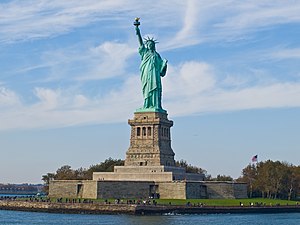
- Image via Wikipedia
I am in the process of drafting a complaint against a doctor, nurse and hospital for extremely egregious medical malpractice that led to the premature and unnecessary death of an Elmira man. Included in my complaint is a claim for punitive damages.
In drafting the complaint I did a fair amount of research about punitive damages in New York, and learned several helpful tips for both practitioners and potential claimants.
At the onset, it is critical to understand what punitive damages are designed to do as well as the strict limitations New York Courts apply in their application. New York’s tort system (the system that allows injured people to recover against the people or entities that caused their injuries through negligence, malpractice and intentional conduct,) generally allows an injured person to only be compensated for actual economic and non-economic injuries directly related to his or her injuries. These types of damages are called “compensatory damages” because they are designed to compensate victims. Compensatory damages include such things as lost wages, medical bills, pain and suffering, loss of enjoyment of life and future treatment costs.
Punitive damages, on the other hand, are designed to punish and deter the wrongdoer or “tortfeasor”. In other words, the purpose of awarding punitive damages is to send a message to the torfeasor and all similarly situated persons or entities that the conduct alleged is so egregious and unacceptable as to require punishment in order to deter others from engaging in the same types of acts.
In 2008 the New York Law Journal published a very interesting article called “The Rules On Punitive Damages.” In this article authors Steven Napalitano and Hayden Coleman explain, “[t]hese damages, also known as exemplary damages, serve a dual purpose: first, to punish the tortfeasor, and second, to deter both the wrongdoer and others similarly situated from engaging in the same conduct in the future.”
There is no question the bar for allowing an injured person to recover punitive damages in New York is set very high. In a recent landmark case, New York’s Court of Appeals (the highest court in New York) observed:
“Punitive damages are permitted when the defendant’s wrongdoing is not simply intentional but evince[s] a high degree of moral turpitude and demonstrate[s] such wanton dishonesty as to imply a criminal indifference to civil obligations”. (Ross v Louise Wise Serv., Inc., 8 NY3d 478, 489, quoting Walker v Sheldon, 10 NY2d 401, 405; see Prozeralik v Capital Cities Communications, 82 NY2d 466, 479; Sharapata v Town of Islip, 56 NY2d 332, 335).
Indeed, Napalitano and Coleman assert “New York courts have strictly limited punitive awards to the most reprehensible instances of wrongdoing; they are only awarded in cases involving gross, wanton or willful fraud, or other morally culpable conduct.”
So, the question emerges: are punitive damages appropriate in my case? Of course, the analysis required to answer this question must be performed on a case-by-case basis. However, there are a few general considerations every practitioner and potential claimant should keep in mind:
1. Does the conduct warrant punitive damages?
This is the million dollar (figuratively speaking, of course) question. In many ways the answer starts in your gut. Do the tortfeasor’s actions make you mad? Really mad? Seething mad? Do they make you want to call the newspaper and the cops and 20/20 because this sort of thing should never happen in the USA? If the answer is a resounding yes, then perhaps you have a claim.
Much more critically, do the torfeasor’s actions make your 72 year-old/very fiscally conservative/wary of lawsuits/cheerleader of tort reform mother-in-law seething, red-faced mad? Too often we see our cases through a rose-colored lens, and, after having sat with a grief-stricken family, believe punitive damages are a given. They’re not. Ever. Vet your case out to your neighbors, your families, your colleagues. Become part of some active list-serves. Read verdict sheets. There is simply no substitute for good old research. It can save you a lot of time (and face) down the road when you are answering the summary judgment motion the defendant will surely bring.
2. Would the conduct have made your mother-in-law seething, red-faced mad at the time it occurred?
Do not overlook this step! Determine when the conduct occurred. Is this a toxic tort case that involved conduct in the 1950’s? Is this an asbestos case where the building was erected 50 years ago?
According to Napalitano and Coleman, “a claimant should be precise in defining the time period of the conduct allegedly justifying punitive damages. In cases where the conduct at issue happened many years ago, as is often the case in the toxic tort context, a plaintiff must be prepared to show that the conduct was outrageous based on the norms and knowledge then prevailing. Defense counsel may seek to engage an expert witness to establish that the conduct was not sufficiently malicious or vindictive at the time. Finally, if circumstances have changed so that the allegedly offending conduct could not happen today, as with a change in the law, defense counsel may properly assert that the goal of deterring future improper conduct cannot be satisfied.”
3. Is the claim for punitive damages insured?
As usual, insurance is the 110 pound gorilla in the room. It is one thing to be a crusader and secure a 10 million dollar punitive damages verdict for your client, but a whole other beast to actually translate the judgment into money your client can take to the bank.
Unfortunately, it appears claims for punitive damages are generally uninsurable in New York. New York’s Court have ruled the public policy underlying a claim for punitive damages – that tortfeasors actually endure punishment in order to deter future bad conduct – is eradicated if insurance companies simply pick up the tab.
The law firm McCullough, Campbell & Lane, LLP created a detailed list of the rules governing the interplay of punitive damages and insurance in all 50 states, including New York:
Directly assessed punitive damages are not insurable in New York. See Public Service Mut. Ins. Co. v. Goldfarb, 425 N.E.2d 810 (N.Y. 1981); Hartford Accident & Indem. Co. v. Village of Hempstead, 397 N.E.2d 737 (N.Y. 1979); Soto v. State Farm Ins. Co., 600 N.Y.S.2d 407 (N.Y. App. Div. 1993), aff’d 635 N.E.2d 1222 (N.Y. 1994); National Union Fire Ins. Co. of Pittsburgh, Pa. v. Ambassador Group, Inc., 556 N.Y.S.2d 549 (N.Y. App. Div. 1990), appeal dismissed, 571 N.E.2d 85 (N.Y. 1991).
In addition, the court in Home Ins. Co. v. American Home Products Corp., 550 N.E.2d 930 (N.Y. 1990), aff’d in part, rev’d in part, 902 F.2d 1111 (2d Cir. 1990), applied the prohibition to out-of-state punitive damages awards for which the insured seeks coverage in New York. The court pointed out that “the punitive nature of the award, coupled with the fact that a New York insured seeks to enforce it in New York against a New York insurer … calls for the application of New York public policy.” 550 N.E.2d at 933. See Zurich Ins. Co. v. Shearson Lehman Hutton, Inc., 642 N.E.2d 1065 (N.Y. 1994) (noting that only when a statute allowing indemnification awards damages that serve a wholly punitive, and not compensatory, purpose are they precluded by New York policy).
Vicariously assessed punitive damages are not insurable in New York. See Zurich Ins. Co., 642 N.E.2d 1065.
This of course does not mean claims for punitive damages should never be asserted in NY, nor does it mean they are always uninsured. It simply means practitioners should have their eyes wide open with respect to collections matters.
Thanks for reading!
Christina
_________________________________
Christina Bruner Sonsire, Esq.
NY & PA Injury & Malpractice Lawyer
Ziff Law Firm, LLP
303 William Street
Elmira, New York 14902-1338
csonsire@zifflaw.com
Office: 607.733.8866
Toll-Free: 800.ZIFFLAW (943.3529)
Web: zifflaw.com
Blog: NYInjuryLawBlog.com


